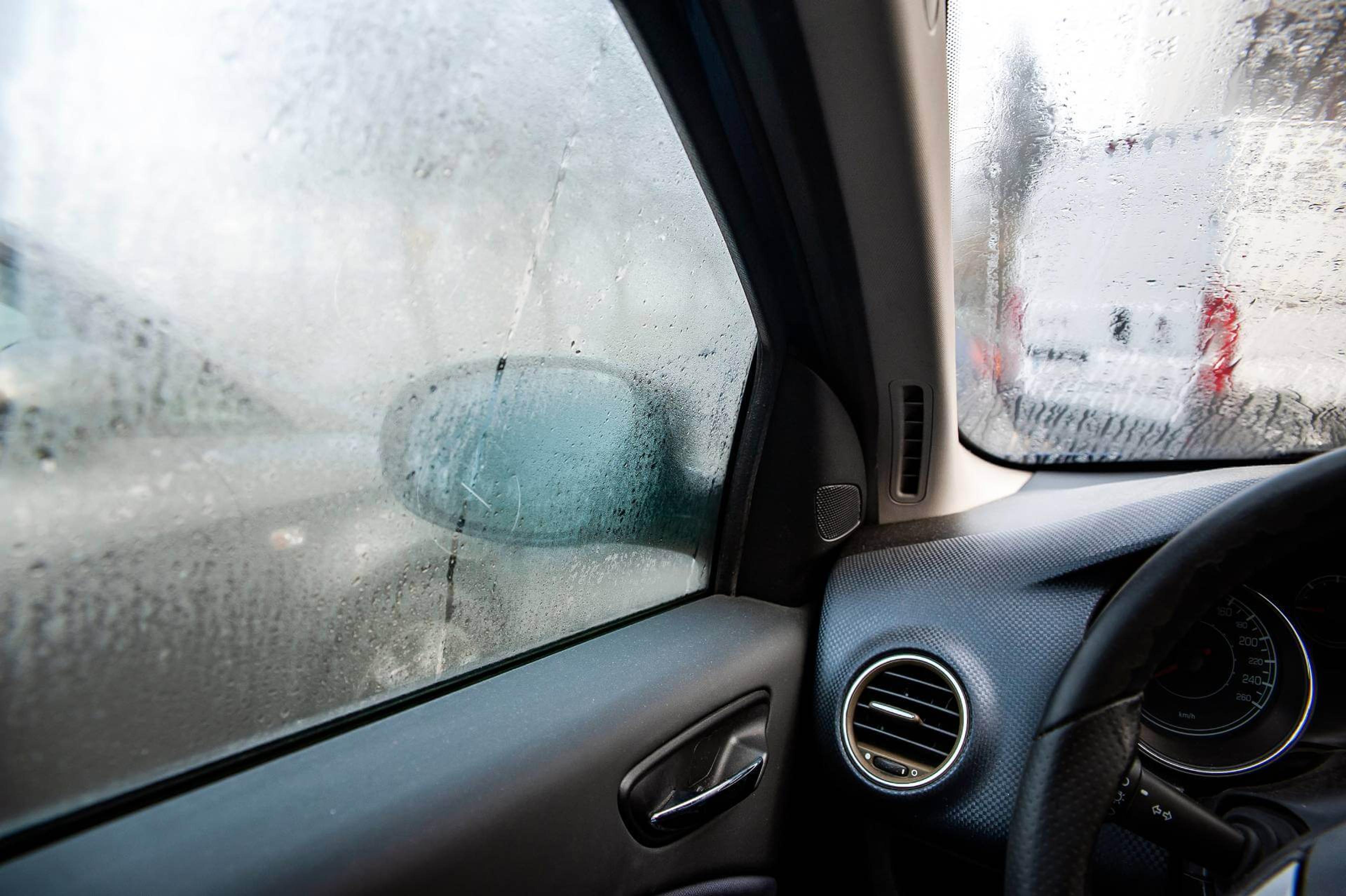
Driving with a foggy window is not only frustrating but also extremely dangerous. Reduced driving visibility can lead to stressful moments and even accidents, so it’s crucial to learn how to stop the windshield from fogging up before hitting the gas pedal.
There are lots of effective defogging techniques that can help keep your windows crystal clear, ensuring your travels are safe, smooth, and hassle-free. From homemade remedies to built-in technologies, let’s go through some of the most effective ones and never again compromise your ability to navigate the road safely.

Looks can be deceiving!
Don't risk your safety - check it with carVertical first
Why do windshields fog up?
Windshields usually fog up due to condensation. It’s a natural process that occurs due to temperature differences between your car’s interior and the outside.
Simply put, when warm, moist air comes into contact with a lower-temperature surface (the windshield), the excess moisture transforms into tiny water droplets that cling to the windshield’s surface. This moisture can come from sources like your breath or wet clothing (e.g., snowy shoes or coats).
Among the factors that contribute to windshield fogging are:
- Dirt on the windshield
- Leaky windows
- Clogged cabin air filters
- HVAC (heating, ventilation, and air conditioning) system malfunctions
While faulty systems can lead to improper air circulation and increase the humidity inside the car, dirt on the windshield often creates a surface perfect for water droplets to cling to.
Although less common, windows can also fog up in the summer. For example, if the air conditioner is set to a very low temperature on a hot day, it can cause the inside of the car to be much cooler than the outside air. When warm, humid air cools from the windshield, it condensates and leads to fogging.
How to prevent fog on the windshield

Whether you’re contending with chilly winter mornings, a sudden rain shower, or the sweltering heat of summer, dealing with obscured visibility is crucial before taking off.
Below are some practical tips on how to keep your windshield from fogging. Just a heads up – you don’t have to use all of them at once, find what works best for you.
1. Keep your windows clean
A simple yet often underestimated solution to stop the windshield from fogging is keeping it as clean as possible.
Over time, various substances like dirt, residue from pollution and cleaners, tobacco smoke (if you smoke inside the car), or other airborne contaminants can accumulate on the windshield, creating an uneven surface that’s more prone to fogging. Therefore, cleaning your windows both inside and outside is important to reduce the likelihood of moisture buildup.
For this, use a high-quality glass cleaner, preferably one specifically intended for car glass. Most regular glass cleaners contain ammonia that can be great for streak-free cleaning but can cause damage to car window tints. You can also make a windshield cleaner at home by mixing water, white vinegar, and dishwashing liquid – in fact, you can choose from different “recipes” online, whichever suits you best.
2. Use anti-fog products
Once your windows are clean, consider using anti-fog products. They’re specifically designed to reduce fogging on the windshield and can be an effective solution in addition to your other efforts.
A typical anti-fog for car windows works by creating a thin hydrophilic (water-attracting) coating on the glass surface that spreads moisture evenly, preventing fog formation. Anti-fog can come in many forms, such as sprays, wipes, transparent films or coatings, adhesive-backed inserts, and similar, so you can choose the most convenient.
While some of them require constant re-application (sprays, wipes), others can provide a solution that lasts for several months or longer (coating).
3. Keep your clothes as dry as possible

Brushing off your clothes and kicking the snow off your shoes is a well-known ritual done before entering a car in winter. Most do it to prevent dirt inside the vehicle, but it can also help keep the windshield from fogging. How?
Wet clothes retain moisture that can evaporate into the air, increasing humidity levels around them. When you enter a car with a coat that is wet from snow, that moisture gets released and comes into contact with the windshield, leading to fogging.
Although challenging, try not to “bring” moisture from the outside. Also, if you already have wet clothes in the car (e.g., visited an aqua park or had a snow battle), keep them in a separate compartment to prevent condensation.
4. Use fresh air mode instead of air-recirculation
During the winter months, it’s recommended to avoid the air-recirculation button, as this mode allows the ventilation system to reuse the air that’s already inside the car. If there’s moisture in the cabin, air recirculation will just trap the humidity, resulting in misted windows.
Instead, use a standard fresh air mode that brings in the air from outside. Although you may not want to bring freezing cold air into your car, it won’t be that bad after going through your car’s heater core.
Fresh winter air is less likely to contain moisture, so it can help reduce the humidity levels inside the car and de-fog your windows a lot quicker. Besides, it can contribute to better air quality, especially if you’re traveling with more passengers, as it helps remove any accumulated carbon dioxide.
5. Activate the defroster
Fresh air mode and defroster are both part of the car’s ventilation system. And while they may sound very similar, they serve different purposes.
Fresh air mode is primarily aimed at maintaining normal ventilation, and the defroster is specifically designed to ensure maximum visibility while driving.
Therefore, you can use the defroster to remove frost, ice, and – you guessed it – fog from your car windows. Depending on its location, the defroster can work by either directing heated air onto the windshield (front window) or using heat grids to generate warmth (rare window).
Today, most passenger cars have defrosters, but they’re rare in pickup trucks and bigger vans. There’s typically a dedicated button or setting for it – it may be labeled as “Defrost,” “Rear Defrost,” or have a symbol of a car window with wavy lines.

6. Let your AC and heater work together
Using the AC in winter may sound like a bad idea, but it can effectively prevent fog when combined with the heater. This duo can help maintain a comfortable car temperature while reducing humidity levels.
Warmer air can hold more moisture than cold air, therefore, by warming up the car’s interior, you’re increasing the air’s capacity to retain moisture. The AC’s function is the opposite – it cools the air, which leads to reduced humidity.
By using the AC and heater in conjunction, you can maintain a reasonable temperature while benefiting from the AC’s moisture-removing properties. In the colder weather, when using the AC alone might be uncomfortable, this method can help keep the right balance and solve the problem.
7. Use a dehumidifier
Since fogging is all about moisture control, it makes sense to keep something that can remove it in your car. This can be a portable device called a dehumidifier, special bags that absorb moisture, or you can also try a couple of hacks using things you can often find at home.
Portable car dehumidifiers usually plug into a power source like a USB port. They work by drawing in moist air and passing it over a cooling element, which causes the moisture to condense into water droplets. The collected water is stored in a reservoir, and the dry air is released back into the cabin.
Dehumidifier bags are filled with substances that effectively absorb and retain moisture from the air, helping to reduce humidity levels in the car. If you have one, place it in the problematic area, in this case, on your dashboard close to the windscreen. You can also make one at home by filling a sock with cat litter or rice. Another option is to leave a container of baking soda in your car, which can also help reduce unwanted odors.
Keep in mind that while these bags can be helpful, they are typically used in addition to other measures mentioned above.
8. Get your HVAC system inspected
If your car’s windows are consistently fogging up, even if you’re trying everything, it could be a sign to get your HVAC system inspected. Common problems usually include clogged or dirty air filters, malfunctioning blower motor, faulty temperature control mechanism, refrigerant leak, and more.
Even though it may seem insignificant, any of those issues can be the reason why your car windows are fogging up, leading to obscured visibility. That’s why proper and regular car maintenance, including HVAC and similar systems, is crucial to everyone’s safety on the road.

Check your registration number
Avoid costly problems by checking a vehicle's history. Get a report instantly!
Frequently asked questions

Article by
Renata Liubertaitė
Renata is a writer with over 8 years of experience in publishing, marketing, and SaaS companies. Writing in various fields and covering highly technical topics has taught her to turn complex things into something everyone can understand. When not writing for carVertical, she loves DIY projects and spontaneous bike rides.
